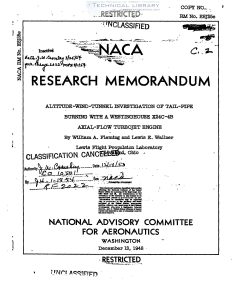naca-rm-e8j25e
- Version
- 128 Downloads
- 1.51 MB File Size
- 1 File Count
- April 21, 2017 Create Date
- April 21, 2017 Last Updated
National Advisory Committee for Aeronautics, Research Memorandum - Altitude-Wind-Tunnel Invetigation of Tail Pipe Burning with a Westinhouse X24C-4B Axial Flow Turbojet Engine

Thrust augnentation of an axial-flow type turboJet engine by
burning fuel in the tail pipe has been "investigated in the HAGA
Cleveland altitude wind tunnel. The performance was determined
over a range of simulated flight conditions and tail-pipe fuel
flows. The engine tail pipe was modified for the investigation to
reduce the gas velocity at the inlet of the tail-pipe combustion
chamber and to provide an adeguate seat 'for the flame; four such
modifications were investigated.
The highest net-thrust increase obtained in the investigtion
was 86 percent with a net thrust specific fuel consumption of 2.91
and a total fuel-air ratio of 0.0525. The highest combustion effi-
ciencies obtained with the four configurations ranged from 0.71
to 0.96 . With three of the tail-pipe burners, for which no
external cooling was provided, the exhaust nozzle and the rear part
of the burner section were bright red during operation at high tail-
pipe fuel-air ratios. With the tail-pipe burner for which fuel and
water cooling were provided, the outer shell of the tail-pipe
burner showed no evidence of elevated temperatures at any operating
condition.
Thrust augmentation. of turboaet engines is of importance in
increasing their usefulness and range of application. Utilization
of the tail pipe for burning fuel provides a practical cycle for
increasing the thrust of turboaet engines. This thrust increase
is obtained without increasing the maximum temperature or stresses
in the turbine buckets or otherwise disturbing the normal cycle of
engine operation, provided that the tail-pipe nozzle area is
increased. A variable-area exhaust nozzle is therefore required to
obtain maximum thrust both with and without tail-pipe burning.
A broad research program on thrust augmentation is being con-
ducted at the NACA Lewis laboratory. As part of this program,
an investigation of thrust augmentation by means of tail-pipe burn—
ing was coniucted in the NACA Lewis altitude wind tunnel from
May to August 1947 to study several tail-pipe—burner configurations
on an axial-flowu-compressor type turchet engine with a thrust
rating of 5000 pounds. Tail-pipe-burning results obtained on
another axial-flow-compressor type turbodet engine in the altitude
wind tunnel are reported in references 1 and 2 and results obtained.
at static sea-level conditions are presented in reference 5.
| File | Action |
|---|---|
| naca-rm-e8j25e Altitude-Wind-Tunnel Invetigation of Tail Pipe Burning with a Westinhouse X24C-4B Axial Flow Turbojet Engine.pdf | Download |

Comment On This Post